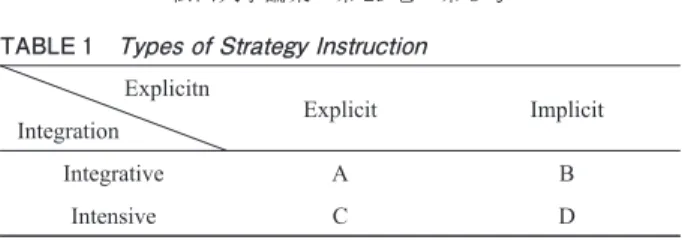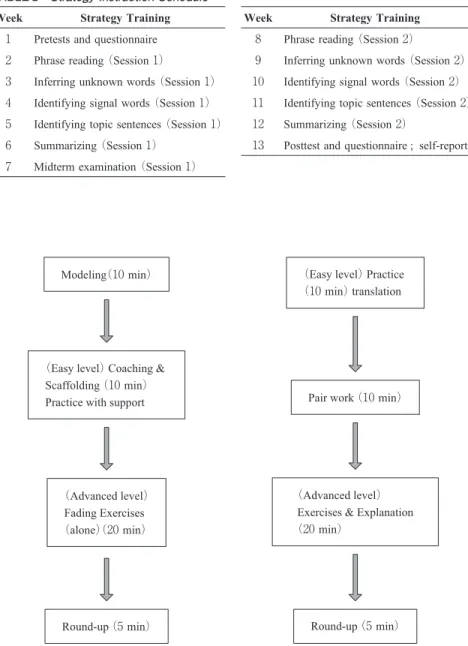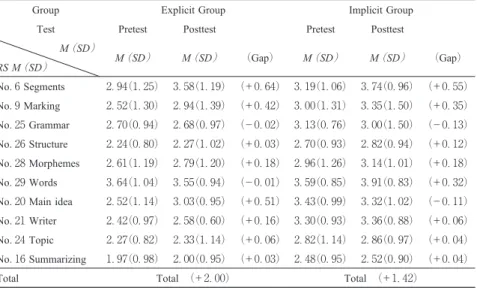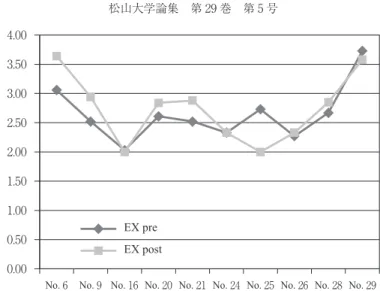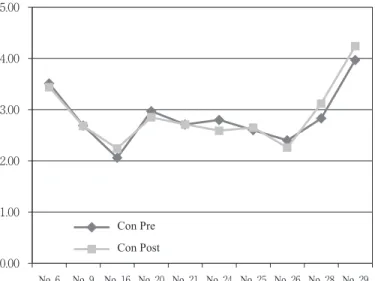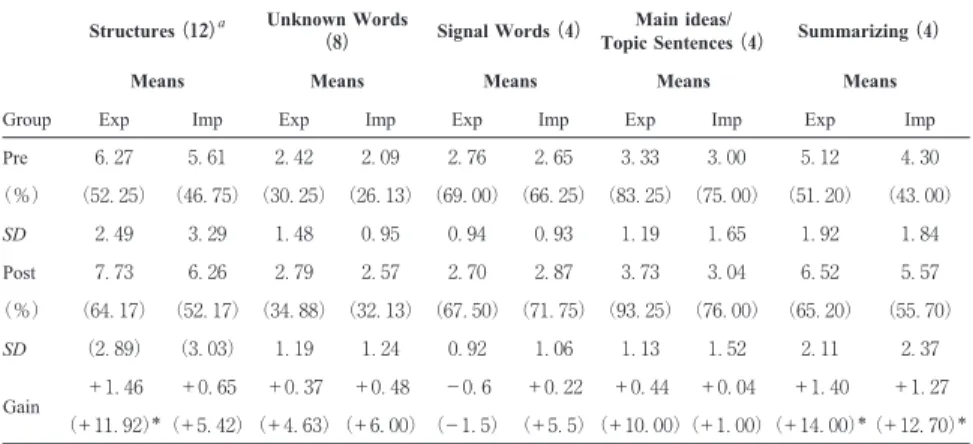第 巻 第 号 抜 刷
年 月 発 行
Effects of Explicit and Implicit Strategy
Instruction on Reading Strategies
Effects of Explicit and Implicit Strategy
Instruction on Reading Strategies
Yukiko Taki
Abstract
This paper examines how explicit and implicit instruction on reading strategies affects the frequency of reading strategies and reading comprehension in Japanese EFL learners. Participants were Japanese college students of lower intermediate English proficiency who received explicit or implicit instruction on five strategies(phrase reading, inferring unknown words, identifying signal words, identifying topic sentences, and summarizing) for four months. A general English reading test and questionnaire on frequency of strategy use were administered to three groups(explicit, implicit, and control)before and after the treatment. To examine linguistic achievement of instructed strategies, a reading strategy test was administered to the treatment groups(explicit and implicit). After four months, the frequency of most instructed strategies increased in both treatment groups, with no increase shown in the control group. The frequency of strategy use was slightly higher in the explicit group than in the implicit group. Mean posttreatment general reading test scores were not significantly different among the three groups, indicating no instruction effects. The reading strategy test showed that more strategy sections increased in the explicit group than in the implicit group, suggesting that explicit instruction might be more effective for some strategies, such as phrase reading and identifying topic sentences.
.Introduction
In recent years, L and L education has increasingly supported instruction on explicit strategies(Cohen, ; Grabe, ). Since the s, numerous studies have examined whether explicit reading strategies develop L learners’ reading
comprehension(Barnett, ; Carrell, Pharis, & Liberto, ; Raymond, ). However, compared with the vast number of studies reporting the effects of explicit reading strategy instruction, empirical studies on implicit reading strategy instruction are scarce(Takeuchi, ).
In the early theoretical groundwork of strategy instruction, Oxford et al.( ) classified strategy instruction into two methods : explicit and implicit. Here, explicit instruction means teaching strategy directly, intentionally, and systematically, whereas implicit instruction means that strategies are not explicitly taught in systematic ways.
Explicit instruction is considered more effective than implicit instruction in terms of the attitude of learners and establishment of learning(Cohen, ; Dadour & Robbins, ). Cohen( ) suggested that “explicit strategy instruction provides the most efficient way for learners’ awareness to be heightened” (p. ). The question arises whether implicit training of strategies improves
learners’ strategy use and reading comprehension.
This paper describes how explicit and implicit instruction of reading strategies affect reading comprehension and frequency of strategy use among Japanese EFL learners.
.Review of Explicit and Implicit Instruction Studies
. Concepts of Explicit and Implicit InstructionFirst, the notion of explicit is compared with the notion of implicit. Explicit is defined in the American Heritage Dictionary of the English Language(Patron, )as “fully and clearly expressed ; leaving nothing implied,” “fully developed or formulated,” and “readily observable.”
The concept of explicit is deeply related to conscious and attentional processing in ESL learning(Ellis, Loewen, Elder, Erlam, Philip, & Reinders, ). Schmidt
( ) differentiated consciousness into four interpretations : intentionality (incidental vs. intentional learning), attention (attended vs. unattended learning),
awareness(implicit vs. explicit learning), and control (automatic vs. controlled processes). In this framework, explicit instruction is intentional, involves attended learning and learners engaged in controlled(attentional)reading processes(see Table for detailed characteristics and outcomes of explicit instruction). Thus, explicit instruction indicates that strategies should be introduced systematically and explained clearly in observable instruction styles(Doughty & Williams, ; Housen & Pierrard, ).
According to Schmidt( , ), as summarized by Ellis( ), there are differences between “awareness as noticing (involving perception) and metalinguistic awareness(involving analysis)”. Explaining Schmidt’s argument, Ellis says, “the former involves conscious attention to ‘surface elements’”, while “the latter involves awareness of the underlying abstract rule” controlling linguistics. Schmidt’s conclusion is that “implicit language learning might be ‘learning without metalinguistic awareness’”, although other researchers suggest that learning “at the level of noticing is also possible”(Ellis et al., , p. ). Thus, implicit instruction is incidental and, under the implicit condition, learners are not aware of what they are attempting to learn(Taki, ).
. Types of Strategy Instruction
According to Ikeda( ), there are two types of strategy instruction : explicit /implicit and integrative/intensive(Table ). First, in explicit strategy instruction, strategies are taught directly, intentionally, and systematically, whereas in implicit strategy instruction, strategies are not explicitly taught in systematic ways, as discussed earlier.
activity in the class throughout the course”, whereas in the intensive way they are taught “with no specific relation to other activities in class”(Ikeda, , p. ). In the former, strategy instruction is integrated with the regular course during the entire term, whereas in the latter, strategy instruction usually occurs at the beginning or end of class.
Therefore, there are four methods of strategy instruction based on combinations of explicit/implicit and intensive/integrative dimensions :( )explicit/integrative, ( )explicit/intensive,( )implicit/integrative, and( )implicit/intensive.
Integrative/explicit and integrative/implicit instruction were adopted in the current study as intact regular classes were chosen to incorporate the aims of the courses.
. Previous Studies of Explicit and Implicit Strategy Instruction
During explicit treatment, learners were taught what strategies are, how to use them, and how to adapt them to other situations. During implicit treatment, learners were engaged in situations where strategies were embedded into the task and materials without direct instruction.
As for explicit instruction of reading strategies, results from previous studies cannot be generalized easily due to various factors such as the number and age of participants, participants’ proficiency level, period of instruction, type of strategies
Explicitn
Integration Explicit Implicit
Integrative A B
Intensive C D
TABLE Types of Strategy Instruction
Note. Adapted from EFL Reading Strategies : Empirical Studies and an Instructional Model(p. ) by M. Ikeda, , Tokyo : Shohakusha.
taught, and methods of instruction.
Three studies on explicit strategies instruction of reading comprehension will be discussed next. Two of these studies reported positive results.
In the first study, Raymond( )conducted strategy training for two weeks with high intermediate native English speakers who were studying French at a university. The students first took English proficiency tests. Then, after reading two tests, they took a recall pretest to examine comprehension and a prequestionnaire to assess text-based strategies and metacognitive strategies. Positive effects in the treatment group included significantly higher recall posttest scores than recall pretest scores and better post-treatment scores than pretreatment scores for metacognitive awareness.
Next, Hiromori( )conducted metacognitive strategy instruction with first-year Japanese college students who were divided into a treatment group(n =
)and a control group(n = ). The treatment group was further divided into high, middle and low groups. Each of these groups was treated with cognitive reading strategies(pre-reading preparation, skimming, scanning, and finding topic sentences) and metacognitive strategies (planning, monitoring, and evaluation). The author taught every group. As a result, the treatment group outperformed the control group. Moreover, the low-level group showed considerable gains in the comprehension test, indicating that certain instructed strategies were more effective for particular groups, such as the low proficiency group.
Finally, Kimura( )reported no positive results of metacognitive strategy training of Japanese students. Eighty-nine first-year junior college students majoring in English were divided into three groups :( )a reading-thinking group that utilized a problem-solving process,( )a semantic-mapping group that utilized graphic representation aimed to facilitate readers’ schematic activation, and( )a control group. The author instructed every group. English test results showed no
significant differences between the three groups.
Regarding implicit instruction, Takeuchi( )reported considerable effects of implicit strategy instruction on frequency of strategy use as well as results of explicit strategy instruction. In this study, Japanese female college students with intermediate proficiency were divided into a treatment group( students)and a control group( students). Before implicit strategy treatment, the two groups showed no significant differences in English proficiency. The implicit strategy group received instruction incorporated into a short, four-week study abroad program in the United States, whereas the control group received no special treatment in Japan. The treatment group was treated implicitly for three weeks on strategies of “planning and evaluating the self-study,” “summarizing stories effectively,” and “guessing and confirming,” with specific details taught by experienced American TESOL instructors. The students were asked to complete Oxford’s Strategy Inventory for Language Learning(SILL ; ESL/EFL Japanese version )three times : two weeks before the treatment, immediately after treatment, and two months after returning to Japan. The condition for strategy usage was embedded in activities(e. g., tasks, materials, and homework), although instructors were not allowed to explain strategies directly in class.
Takeuchi( )reported considerable treatment effects regarding the extent and frequency of strategy use for Japanese students studying in the United States. Strategy use of important and less important strategies increased after instruction. In addition, participants retained most of their strategy usage two months after treatment. These results indicate that implicit instruction is likely to have effects on strategy use. However, as a study limitation, Japanese students in the United States might have had some advantage in acquiring reading strategies in English compared with their Japanese counterparts in Japan. Moreover, pre- and posttests of language proficiency should have been administered along with questionnaires on the
frequency of strategy use.
Previous studies on reading strategy instruction examined either improvement in general reading abilities or frequency of strategy use. Furthermore, it is questionable whether a general reading test is an appropriate tool for examining effects of strategy instruction. A strategy test should be conducted when examining effects of explicit and implicit instruction on any differences in achievement in acquiring strategy use(Raymond, ). Also, a triangulation method that includes more than one method might be an effective method for analyzing multiple data from different viewpoints(Raymond, ). However, few previous studies have reported the effects of strategy instruction by conducting both explicit and implicit treatment of reading strategies.
Against this background, this study aimed to determine(a)whether any differences exist between explicit instruction and implicit instruction in frequency of strategy use and general reading ability, and(b)how differences in instruction method affect language achievement of each instructed strategy.
The following research questions were examined :
. Are there any differences in reading ability among the treatment groups (explicit and implicit instruction) and control group before and after
treatment ?
. Are there any differences in strategy use among the treatment groups (explicit and implicit instruction) and control group before and after
treatment ?
. How does explicit and implicit instruction affect language achievement for each instructed strategy ?
.Methods
. ParticipantsParticipants were first-year college students with lower-intermediate ESL proficiency, majoring in business administration, economics, social studies, or law at a four-year university located in a middle-sized city in Japan. They were divided into an explicit instruction group(n = ), implicit instruction group(n = ), and a control group(n = ).
Initially, there were students, some of whom were absent from class and unable to take either the reading pre- or posttest. Thus, a total of students took both tests(explicit instruction group : ; implicit instruction group : ; control group : ). The proficiency level of the three groups ranged from to converted from the Test of English for International Communication(TOEIC) Bridge to the TOEIC.
. Procedure and Instruction
Due to class schedules, random allocation of participants was not possible. Instead, three intact first-year English classes were randomly assigned to the groups for the experiment(explicit instruction treatment and implicit instruction treatment) and a control group for the study. All three classes were taught by the author.
The aim of the classes was to develop reading abilities, using the same reading text on British food and literature published by a Japanese publisher.
Based on previous studies, factors influencing training effectiveness were taken into account. First, the author taught all the classes to control the teaching variable. Second, students with lower intermediate ESL proficiency level were chosen. Third, regarding effective methods in previous treatments, both a proficiency test and questionnaire have been shown to be effective and utilized. Finally,
metalinguistic knowledge was taught to facilitate the effects of strategy treatment. Three classes were randomly assigned to the treatment groups(explicit and implicit) and the control group.
The explicit group received direct strategy training for min in each of classes during one semester. The implicit instruction group did not receive direct strategy training during the same conditions(time and period). The control group engaged in English conversation activities and did not receive strategy instruction. During nonstrategy instruction class times, every class in this study followed the same lesson plans(i. e., reading one chapter of the same textbook per class). As shown in Table , five strategies were chosen(i. e., phrase reading, inferring unknown words, inferring signal words, identifying topic sentences, and summarizing)based on previous studies and a strategy textbook(Ushiro, Nakagawa, & Pavoux, ).
As shown in Figure , a teaching session was divided into four stages : ( )instructor’s explanation and modeling ( min);( )scaffolding : individual exercises with support( min);( )fading exercises without support( min); and( )a round up( min). The author taught one strategy at a time to the participants, while developing metalinguistic knowledge, including grammar rules, syntactic structures, and discourse structures, in relation to strategic knowledge. Pair work was utilized in both treatment groups because most L learners prefer pair work to help each other rather than individual work during activities.
The implicit group was not directly instructed to use the target strategy in class. Instead, they were led to situations where they had to use the target strategies in each class. Each session was composed of four stages : having students answer questions(approximately min),pair work( min),exercises and an explanation from the teacher(approximately min), and a round up( min)(Figure ). To minimize the Hawthorne effect, participants in the treatment groups were not
Modeling(10 min)
(Easy level) Coaching & Scaffolding (10 min) Practice with support
(Advanced level) Fading Exercises (alone)(20 min)
(Easy level) Practice (10 min) translation
Pair work (10 min)
(Advanced level) Exercises & Explanation (20 min)
Round-up (5 min) Round-up (5 min)
Week Strategy Training Pretests and questionnaire Phrase reading(Session )
Inferring unknown words(Session ) Identifying signal words(Session ) Identifying topic sentences(Session ) Summarizing(Session )
Midterm examination(Session )
Week Strategy Training Phrase reading(Session )
Inferring unknown words(Session ) Identifying signal words(Session ) Identifying topic sentences(Session ) Summarizing(Session )
Posttest and questionnaire ; self-report TABLE Strategy Instruction Schedule
informed about the treatment because the tests and questionnaire were part of the syllabus.
. Materials
Two types of handouts and reference materials were prepared for explicit and implicit instruction, although both lessons used the same English sentences and passages during the instruction period. English passages were mainly selected from the senior high school writing textbook, Crown English Writing(Shimozaki et al., ), and a textbook on reading strategies(Ushiro et al., ). The level of reading materials was deemed appropriate for the participants based on reflective reports. Handouts introduced one strategy at a time and consisted of three exercises each in increasing difficulty from basic to advanced level(phrasing reading, inferring unknown words, identifying signal words, identifying topic sentences, and summarizing).
As stated earlier, under explicit instruction, comprehension questions were created to activate the instructed strategy directly. For example, if the day’s target strategy was summarizing, participants were asked to summarize a passage.
However, under implicit instruction, handout questions did not include the target strategy. Instead, participants without noticing were led implicitly to activate the strategy of summarizing passages. For example, if the strategy was to summarize a passage, participants were asked to answer questions that included key concepts in the passages(see Appendix A).
. Instruments
.. General Reading Test and Questionnaire
Two main instruments were used to assess both groups : a general English reading test and a questionnaire examining frequency of strategy use. They were
administered before and after four months of instruction.
The third- and fourth-grade multiple-choice General Tests of English Language Proficiency(G-TELP), was used as the general reading test, the conducted for two groups for forty-five minutes. It is a multiple-choice reading comprehension test consisting of items. The same test was used as a posttest to control for the content variables. The questionnaire, comprised of strategy use questions, was distributed to the two groups just after they took the general reading test. It was designed to examine how the frequency of strategy use changed before and after instruction. Question items, referring to a previous study(Ikeda & Takeuchi, ), were distributed to both groups. The participants answered using a -point Likert scale( : did not use the strategy at all ; : seldom used the strategy ; : sometimes used the strategy ; : often used the strategy ; : always used the strategy).
.. Reading Test
For only the experimental group, a reading strategy test was created by the author to examine linguistic achievement(i. e., whether the participants were able to use instructed strategies successfully in answering reading comprehension)(see Appendix A). It was comprised of five sections : marking slashes and writing the meaning of sentences( items), identifying reference words( items), inferring unknown words( items), selecting appropriate signal words ( items), and finding topic sentences( items). Two passages were selected from Ushiro et al. ( ). The readability of two passages was as follows. The first passage ‘Free from One’s Body’( words): Flesch Reading Ease - . , and Flesch Kincaid Grade Level - . ; and the second passage ‘Moth or Butterfly’( words): Flesch Reading Ease - . , and Flesch Kincaid Grade Level - . . Both passages are appropriate for the participants with intermediate proficiency level.
Explicit Group
(n = ) Implicit Group(n = ) Control Group(n = ) Pretest Posttest Pretest Posttest Pretest Posttest
Mean . . . . . .
SD . . . . . .
r(effect size) . . .
Gain . . .
TABLE Pre- and Posttest Results of General English Reading Test
Prior to the study, a pilot study was conducted with students to check the reliability of the reading strategy test. There was strong correlation between the total of TOEIC scores and the reading strategy test(Pearson’s coefficient correlation r = . , p < . ). The correlation between the post-G-TELP test and the post-reading strategy test was considerably strong(r = . , p < . ). All the questions except phrase reading were scored using a -point scale( for an incorrect answer ; for a correct answer). Two raters scored the answers and interrater reliability was checked. Interrater reliability was % for the pre-test and % for the posttest. After discussing the few differences, all the disagreements were resolved.
.Results
. General English Reading Test ResultsPre- and posttests were conducted during the four-month period.
One-way ANOVA was conducted to examine differences in general reading abilities before treatment to identify equivalences among the three groups. Four months might be enough time to avoid a relay effect. As a result, there were no significant differences in mean scores among the three groups(F( , )= . ; p = . , ns).
Table shows pre- and posttest scores of the general English test. There were no significant differences in the general reading test among the three groups (F( , )= . ; p = . , ns), indicating no treatment effect in the treatment groups, although the explicit group’s mean scores showed the most gain(r = . ). All three groups showed increased reading ability after four months, indicating that reading ability increased significantly after four months apart from any method (p < . ).
. Reading Strategy Results
Among strategies related to implicit or explicit instruction, strategies were selected.
Table shows a descriptive analysis of mean scores with standard deviations of the frequency of strategy use in the three groups(explicit, implicit, and control).
Group Explicit Group Implicit Group
Test Pretest Posttest Pretest Posttest
M(SD) RS M(SD) M(SD) M(SD) (Gap) M(SD) M(SD) (Gap) No. Segments .( . ) .( . ) (+ . ) .( . ) .( . ) (+ . ) No. Marking .( . ) .( . ) (+ . ) .( . ) .( . ) (+ . ) No. Grammar .( . ) .( . ) (− . ) .( . ) .( . ) (− . ) No. Structure .( . ) .( . ) (+ . ) .( . ) .( . ) (+ . ) No. Morphemes .( . ) .( . ) (+ . ) .( . ) .( . ) (+ . ) No. Words .( . ) .( . ) (− . ) .( . ) .( . ) (+ . )
No. Main idea .( . ) .( . ) (+ . ) .( . ) .( . ) (− . )
No. Writer .( . ) .( . ) (+ . ) .( . ) .( . ) (+ . )
No. Topic .( . ) .( . ) (+ . ) .( . ) .( . ) (+ . )
No. Summarizing .( . ) .( . ) (+ . ) .( . ) .( . ) (+ . )
Total Total(+ . ) Total(+ . )
TABLE Descriptive Statistics of Mean Scores for Instructed and Related Strategies for Three Groups
Ten strategies related to the instructed strategies were chosen. Figure shows pre-and postmean scores of strategies related to the instructed strategies for the explicit group, Figure shows that for the implicit group, and Figure shows that for the control group.
As shown in Figure (control group), pre- and posttest means indicated very little difference in the frequency of any strategy. In contrast, the explicit group showed a wide gap between pre- and posttests for No. (paying attention to clausal/ phrasal segments from phrase reading)and No. (guessing main points from main ideas)(mean gain : + . , + . ). Moreover, other strategies such as Nos. , , , , and showed small increases after treatment. However, the control group showed small differences overall between pre- and posttests. In the implicit group, No. (paying attention to clausal/phrasal segments from phrase reading)also showed a big posttreatment increase(mean gain : + . ). Small increases were observed in other strategies such as No. (marking), No. (paying attention to
Group Control Group
Test Pretest Posttest
M(SD) RS M(SD) M(SD) (Gap) No. Segments .( . ) .( . ) (− . ) No. Marking .( . ) .( . ) (+ . ) No. Grammar .( . ) .( . ) (+ . ) No. Structure .( . ) .( . ) (− . ) No. Morphemes .( . ) .( . ) (+ . ) No. Words .( . ) .( . ) (+ . )
No. Main idea .( . ) .( . ) (− . )
No. Writer .( . ) .( . ) ( )
No. Topic .( . ) .( . ) (− . )
No. Summarizing .( . ) .( . ) (+ . )
Total Total ( . )
No. 6 No. 9 No. 16 No. 20 No. 21 No. 24 No. 25 No. 26 No. 28 No. 29 EX pre EX post 0.00 0.50 1.00 1.50 2.00 2.50 3.00 3.50 4.00 0.00 1.00 2.00 3.00 4.00 5.00
No. 6 No. 9 No. 16 No. 20 No. 21 No. 24 No. 25 No. 26 No. 28 No. 29 Imp Pre
Imp Post
Figure . Frequency of instructed strategy(explicit group).
0.00 1.00 2.00 3.00 4.00 5.00
No. 6 No. 9 No. 16 No. 20 No. 21 No. 24 No. 25 No. 26 No. 28 No. 29 Con Pre
Con Post
No. : Paying attention to clausal/phrasal segments(phrase reading) No. : Marking syntactic units of clausal/phrasal segments(phrase
reading)
No. : Paying attention to grammar rules
No. : Paying attention to sentence structure(phrase reading) No. : Paying attention to morphemes of words(unknown words) No. : Guessing words from the context(unknown words) No. : Guessing main points(main ideas)
No. : Guessing the writer’s intention(main ideas)
No. : Paying attention to topic sentences and subordinate sentences (main ideas)
No. : Summarizing(summary)
sentence structure), No. (paying attention to morphemes of words), and No. (guessing words from the context).
In the treatment groups, some gains were seen in most strategies except No. (both explicit and implicit : paying attention to grammar rules), No. (explicit :
guessing words from the context); and No. (implicit : guessing main points). Compared with results of the control group, the treatment groups substantially increased No. (paying attention to clausal/phrasal segments ; explicit : + . ; implicit : . ; control : . )from phrase reading, No. (marking syntactic units ; explicit : + . ; implicit : + . ; control : + . )from phrase reading, No. (guessing main points ; explicit : + . ; control : . ) from main ideas, and No. (guessing the writer’s intention ; explicit : + . ; implicit : + . ; control : )from main ideas. These results indicated positive effects of the instruction.
. Reading Strategy Test Results
These results indicated significant improvement of both pre- and posttests in the explicit and implicit groups(explicit :F( )= . , p < . ; implicit : F( ) = . , p < . ). Therefore, treatment contributed to the overall improvement in reading comprehension whether treatment was explicit or implicit.
Next, each section of strategy test scores will be addressed below(see Table ). In terms of percentages, phrase reading and identifying main ideas/topic sentences improved more in the explicit group than in the implicit group(explicit : pretest . %, posttest . % ; implicit : pretest %, posttest %). For both groups, identifying main ideas showed the most improvement, whereas guessing unknown words showed the least(explicit : pretest . %, posttest . % ; implicit : pretest . %, posttest . %). In the explicit group, pre- and posttests of structures and summarizing were significantly different(t( )
0 20 40 60 80 100 Pre Post Phrase Reading Pre Post Unknown Words Pre Post Signal Words Pre Post Topic Sentences Pre Post Summarizing Exp Imp (%)**
= . , p < . ; t( )= . , p < . , respectively), whereas guessing unknown words(p = . )and identifying signal words(p = . )showed little increase after treatment. Although not significant, identifying topic sentences increased more in the explicit group than the implicit group(p = . ). In the
Structures( )a Unknown Words
( ) Signal Words( )
Main ideas/
Topic Sentences( ) Summarizing( ) Means Means Means Means Means Group Exp Imp Exp Imp Exp Imp Exp Imp Exp Imp
Pre . . . . . . . . . . (%) ( . ) ( . )( . )( . )( . )( . )( . )( . ) ( . ) ( . ) SD . . . . . . . . . . Post . . . . . . . . . . (%) ( . ) ( . )( . )( . )( . )( . )( . )( . ) ( . ) ( . ) SD ( . ) ( . ) . . . . . . . . Gain + . + . + . + . − . + . + . + . + . + . (+ . )*(+ . )(+ . )(+ . )(− .) (+ .)(+ . )(+ . )(+ . )*(+ . )* TABLE Results of Reading Strategy Test Section for the Treatment Groups
Note. Stra = Strategy ; Exp = explicit group ; Imp = implicit group. a full scores. * p < .
Figure . Percentage of reading strategy test section results for the treatment groups. Note. Figures in the graph indicate percentages.
implicit group, only summarizing was significantly different in pre- and posttests (t( )= . , p < . ). The remaining strategies showed no significant differences (structures : p = . ; signal words : p= . ; unknown words : p = . ), indicating that phrase reading and topic sentences might be more effective using explicit instruction.
. Discussion
Each research question below will be addressed with reference to the study results.
.Were there any differences in reading abilities among the treatment groups
(explicit and implicit instruction)and control group before and after treatment ? No. Gain scores of general reading tests before and after treatment showed no significant differences among the three groups, indicating no treatment effects. Given the short length of most sentences and passages used in this study, more challenging English materials might be needed to develop reading ability. Moreover, there were no significant differences in reading ability, whether the treatment was provided explicitly or implicitly.
.Were there any differences in strategy use among the treatment groups
(explicit and implicit instruction)and control group before and after treatment ? Yes. As Takeuchi( )pointed out, both explicit and implicit instruction increased awareness of strategies, although under explicit instruction, awareness of strategies tended to increase more than under implicit instruction. In contrast, metacognitive awareness of strategy use did not increase in the control group.
Furthermore, awareness of strategy use might be related to various factors such as treatment conditions, learners’ proficiency level and individual factors such as learning style and interest level. Compared with a prior study(Taki, ), the frequency of instructed strategies did not improve markedly under explicit instruction
in the present study(gain gap of . and . , respectively). Explanations for this difference include treatment time( min and min, respectively), participants’ proficiency level(pretest means of the general English reading test were . and . , respectively), and individual learning style and interest level.
.How did explicit and implicit instruction affect language achievement for each instructed strategy ?
Overall, both implicit and explicit instruction showed significant effects. However, explicit instruction was more likely to have more effects than implicit instruction for each strategy. In addition, explicit instruction of some strategies (e. g., phrase reading and topic sentences) might be more effective for
lower-intermediate learners.
.Conclusion and Future Perspectives
As for reading ability, explicit, implicit, and control groups showed no significant differences, although general reading abilities increased in all three groups after four months. The following conditions for instruction should be met when developing reading ability(Macaro, ):( )instructed strategies that are actually effective and( )appropriate teaching materials and an adequate period of instruction. However, once these conditions are met, explicit instruction might be more effective given that mean scores of the explicit instruction group increased the most and its effect size was the largest compared with the other two groups.
Regarding strategy use, both explicit and implicit instruction increased learners’ metacognitive awareness of reading strategies. However, explicit instruction might be more effective than implicit instruction for language achievement of some specific strategies. For some strategies, explicit instruction might be more effective for enhancing reading ability. Moreover, enhancement of metacognitive awareness
might be closely related to the goals of instruction, participants’ proficiency level, learning style, and degree of interest.
There are two limitations in this study. First, treatment materials should have been more challenging. Second, the strategy test constructed for the study should be further checked for reliability and validity.
References
Barnett, M. A.( ). Teaching reading strategies : How methodology affects language course articulation. Foreign Language Annals, , − .
Carrell, P. L., Pharis, B. G., & Liberto, J. C.( ). Metacognitive strategy training for ESL Reading. TESOL Quarterly, ( ), − .
Cohen, A. D.( ). Strategies in learning and using a second language( nd ed.). Harlow, UK : Longman/Pearson Education.
Cohen, A. D.( ). Strategies in learning and using a second language( st ed.). Harlow, UK : Longman.
Dadour, E. S., & Robbins, J.( ). University-level studies using strategy instruction to improve speaking ability in Egypt and Japan. In R. L. Oxford(Ed.), Language learning strategies around the world : Crosscultural perspectives(pp. − ). Manoa, HI : University of Hawaii Press.
Doughty, C., & Williams, J.( ). Pedagogical choices in focus on form. In C. Doughty & J. Williams(Eds.), Focus on form in classroom second language acquisition(pp. − ). Cambridge, UK : Cambridge University Press.
Ellis, R., Loewen, S., Elder, C., Erlam, R., Philip, J., & Reinders, H.( ). Implicit and explicit knowledge in second language learning, testing and teaching. Bristol, UK : Multilingual Matters.
Grabe, W.( ). Reading in a second language : Moving from theory to practice. Cambridge, UK : Cambridge University Press.
Hiromori, T.( ). Metacognitive strategy instruction in L reading. Research Bulletin of English Teaching, , − .
Housen, A., & Pierrard, M.( ). Investigating instructed second language acquisition. In A. Housen & M. Pierrard(Eds.), Investigations in instructed second language acquisition(pp. −
). Berlin : Mouton de Gruyter.
Tokyo : Shohakusha.
Kimura, Y.( ). Metacognitive awareness training and reading comprehension of Japanese EFL learners. JACET Bulletin, , − .
Macaro, E.( ). Strategies for language learning and for language use : Revisiting the theoretical framework. The Modern Language Journal, , − .
Oxford, R. L., Crookall, D., Cohen, A., Lavine, R., Nyikos, M., & Sutter, W.( ). Strategy training for language learners : Six situational case studies and a training model. Foreign Language Annals, , − .
Patron, J.(Ed.).( ). The American Heritage Dictionary of the English Language(th ed.). Boston, MA : Houghton Mifflin Company.
Raymond, P. M.( ). The effects of structure strategy training on the recall of expository prose for university students reading French as a second language. Modern Language Journal,
( ): − .
Schmidt, R.( ). Implicit learning and the cognitive unconscious : Of artificial grammar and SLA. In N. Ellis(Ed.)Implicit and explicit learning of languages(pp. − ). London : Academic Press.
Schmidt, R.( ). Attention. In P. Robinson(Ed.), Cognition and second language instruction. Cambridge, UK : Cambridge University Press.
Shimozaki, M., Matsubara, K., Kuroiwa, Y., Tsujimoto, Chi., Mochizuki, N., Yui, R., Taylor, G., Iida, R., Iwasa, Yo., Sasaki, H., Sugano, A., Watanabe, Y., Deaux, G.( ). Crown English Writing New Edition. Tokyo : Sanseido.
Takeuchi, O.( ). Yoriyoi Gaikokugo gakushuhou wo motomete : gaikokugo gakushu seikousha no kenkyu. Tokyo : Shohakusha.
Taki, Y.( ). Effects of explicit instruction in reading strategies on strategy use and English reading ability of Japanese EFL college students. Annual Review of English Language Education in Japan(ARELE), , − .
Taki, Y.( ). The effects of explicit reading strategy instruction on student strategy use and metacognitive awareness development. Kyoto : Koyo Shobo.
Ushiro, Y., Nakagawa, C. & Pavoux, M. L.( ). Reader’s ark basic : Setting out on a voyage. Tokyo : Kinseido.
Appendix A
読み方のワン・ポイント レッスン Today’s lesson
Strategy Identifying the Main Idea & Topic sentences
Student No.( ) Name( )
今回は文章の書き手が「全体で何を伝えたいのか」とか「何を一番伝えたいのか」を理解 しましょう。「何を伝えたいのか」を理解するのは読解において大切です。この重要な情報 を「主題」や「メインアイディア(main idea)」と呼びます。 文章は main idea を中心に構成されています。メインアイディアを示す手がかりが「主題」 「トピックセンテンス」(topic sentence)」と呼ばれます。 英文のパッセージ(文章)は,複数のパラグラフ(段落)から成り立っています。パラグ ラフには,大事な文(主題文/トピックセンテンス)とその文を説明・補足する文(支持文) があります。どの文が主題に関係した重要な文なのかをみつけ,パラグラフの主題は何かを 読み取る訓練をしていきましょう。
−extracted from the original passages.−
.Euthanasia is also called “mercy killing” or “death with dignity.” Some people have the misfortune to suffer from incurable diseases or intolerable pain. Euthanasia is the practice of helping such people to end their lives. This practice has its opponents and proponents.
.Opponents claim that nobody has the right to kill anyone else, even if he or she asks you to do so. They regard this practice as murder. Christianity, for example, strictly prohibits suicide, and euthanasia is regarded as a form of suicide.
(Explicit instruction) . のトピックセンテンスを選び,下線を引きなさい。 . のトピックセンテンスを選び,下線を引きなさい。 (Implicit learning) .Euthanasia とはどういうことですか。用語を説明しなさい。 .反対者の意見を述べなさい。
